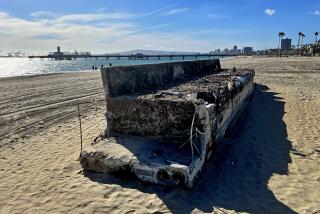Tough Question: How to Clean Up Newport Bay
- Share via
The basic premise of all alternatives has to do with some kind of disposal of toxic sediments, the toxicity of which is directly related to runoff and the leaching through upland soils of such substances as chemical fertilizers and pesticides that are used in gardens.
Is dilution the solution to pollution?
I suspect it is one solution. The working truth of the effect of dilution is well known by everybody who drinks alcoholic beverages. It takes longer to become polluted when each glass of beverage is well diluted.
It follows that the same principle should apply to Upper and Lower Newport Bay. At any rate, the environmental experts are giving the principle a good try.
Entitled “The Newport Bay Watershed: San Diego Creek Comprehensive Stormwater Control Plan, 1983,” the dilution / solution principle is being employed in Phase III of Upper Newport Bay’s rehabilitation project. An ecological reserve, a good part of the Upper Bay has been dredged, with the silt deposited as landfill for housing development.
‘Catch’ Basins in Bay
One of the elements of a favored plan for Phase III is to build “catch” basins within the bay, while at the same time employing land-management practices to reduce sediment at its sources. Alternative plans, proposed by the City of Newport Beach, suggest use of a hydraulic dredge with disposal offshore through a permanent pipeline. Although this seems to be the least costly plan, it is not recommended by the city staff and consultant because of possible delays in obtaining Environmental Protection Agency permits.
Other plans studied include hydraulic dredging with land or scow disposal and clamshell dredging with scow disposal. The basic premise of all alternatives has to do with some kind of disposal of toxic sediments, the toxicity of which is directly related to runoff and the leaching through upland soils of such substances as chemical fertilizers and pesticides that are used in gardens.
Added to this is the voluntary or involuntary dumping of waste materials, such as sewage, pesticides and gasoline on the uplands. These flow into the bay through such tributaries as San Diego Creek.
Pollution From Boats
Boats in the Lower Bay and the southern portion of the upper contribute a share of pollutants from leaching of necessary anti-fouling paints on bottoms, spills of marine fuels and discharges from marine toilets. Pollution from these sources is believed to be minimal in comparison to the flow of toxic substances from the surrounding land mass, especially during rainy periods.
It has long been illegal to pump out marine toilets into the bay. Most boaters are aware of this and refrain from doing so.
Newport Beach Mayor Phil Maurer has ordered the installation of about seven new marine pump-out stations, at strategic locations, to remove sewage from vessels equipped with holding tanks. They should be in place by the middle of summer. This should help to eliminate, by a modest degree, pollution by raw sewage from boats.
However, the larger problem, toxic flow from the uplands, remains.
Lack of Copperation
All solutions to this major problem seem somewhat inadequate. Assemblyman Gil Ferguson (R-Newport Beach) is addressing himself to the problem, pointing to what he calls the uncoordinated welter of local, state and federal agencies that concern themselves with environmental problems. Aside from the Santa Ana Regional Quality Control Board, which wields a small amount of local autonomy, there is a lack of cooperation, communication and objectives between the various agencies, says Ferguson.
While urging reform along this line, Ferguson has adopted a wait-and-see policy in regard to improvement of the water quality of Newport Bay. If there is no improvement in the bay and in the coordinated efforts of the agencies to improve it in about two years, he says, he will seek legislation to create a “single entity or joint powers authority” to implement and coordinate environmental matters.
Unfortunately, the dilution / solution principle, which seems to be the only feasible way to minimize the effect of toxic wastes, along with such land-management practices as restrictions and policing, does control the amount of natural sediment that finds its way into the sea. It is precisely this sediment that helps create and maintain our beaches.
When Ferguson claims he wants to clean up the bay and at the same time replenish our beach sand, he is talking about an ideal that is impossible to achieve, except by importing sand from other sources or by building jetties or groins to divert the litoral flow of sediment that hasn’t been controlled.
And this creates yet another set of problems.
Alas, Mother Nature intended sedimentary flow. It is man on the land masses, cutting, filling and polluting, who has fouled up the natural processes.
And now, before it’s too late, man must learn how to take some wise compensatory action. Ferguson, Maurer and others who care are at least pointing in the right direction.
More to Read
Sign up for Essential California
The most important California stories and recommendations in your inbox every morning.
You may occasionally receive promotional content from the Los Angeles Times.













